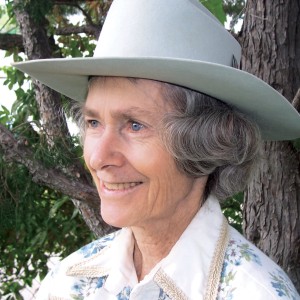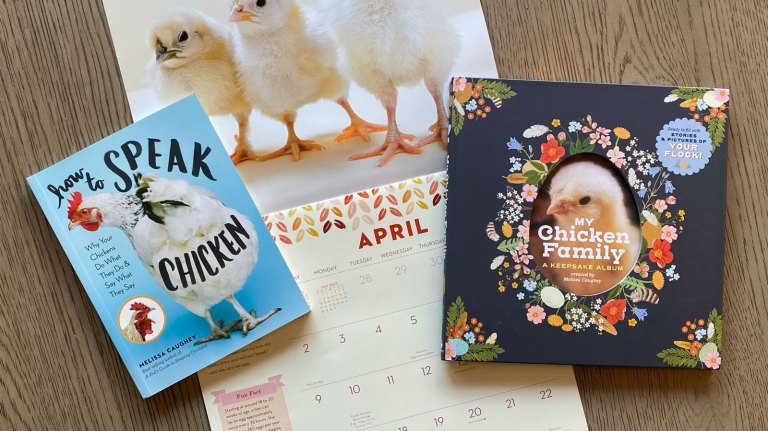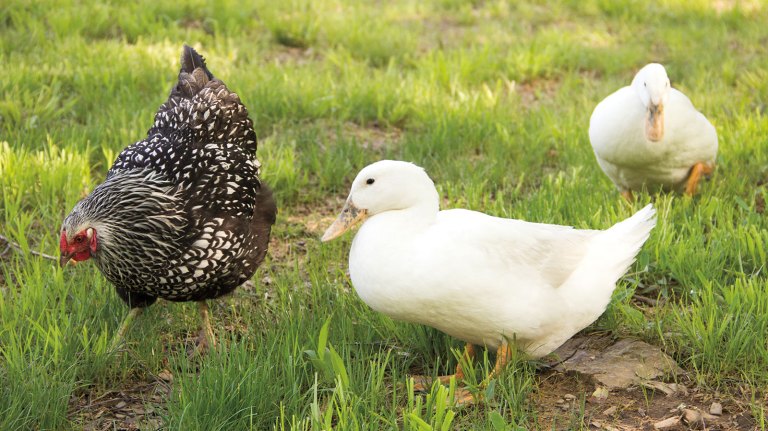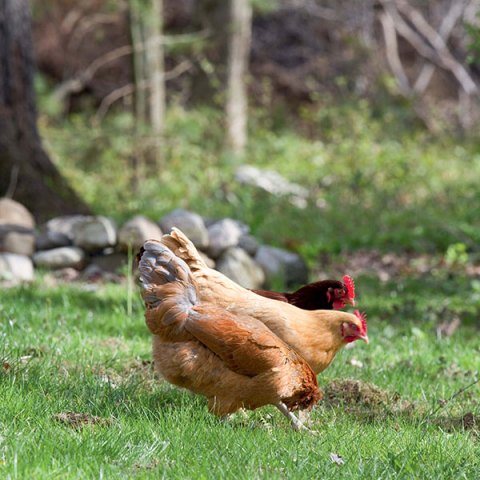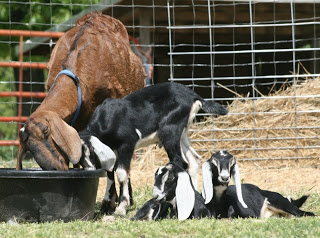Notes from Sky Range Ranch — A Very Special Cow Dog
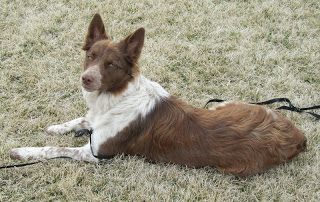
Fred came from a litter of pups bred to be super cow dogs. Her sire, Ike, is three-quarters red border collie and one-quarter bull terrier, bred by a rancher from Australia who moved to Montana. The border collie was originally bred to work sheep and is very intelligent but generally not as aggressive as some of the other working breeds. Ike’s breeder added bull terrier to his border collies, to get a little more aggression — to create the smartest sheepdog that could be aggressive enough to work the toughest cattle. Most stockmen who use dogs for working cattle feel that the border collie is smarter than the Blue Heeler, but also more timid. This particular rancher felt that adding some bull terrier made an excellent mix for a good cow dog.
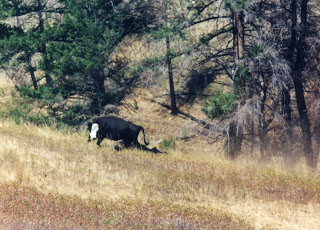
to bring a wayward belligerent cow back to the herd.
He passed away a few years ago, however, with no place for his dogs to go. Dan Mulkey (a young rancher near Lima, Montana) took a newly weaned litter, kept a male that he named Ike, and adopted out the rest of the pups. Dan spent a lot of time with Ike as a pup, progressing through ducks and sheep in his training, and Ike became a top cow dog. Ike’s pups are only one-eighth bull terrier, but most of them are more aggressive than border collies and have the tenacity to handle rough cattle.
In early February 2010 Ike was bred to a “fuzzy” cow dog owned by one of Dan’s rancher friends near Dillon, Montana. These are a unique type of border collie mix bred by some of the ranchers in eastern Idaho and are locally known as Pahsimeroi Fuzzies. These dogs are longer-haired than a typical border collie and without the white markings.
Our son Michael and his wife Carolyn, who live here on our creek (near Salmon, Idaho), are good friends with one of our neighbors — Dan’s father, Bruce Mulkey — and often help Bruce gather and work cattle. They had seen Ike work cattle on several occasions when Dan came to visit his dad.
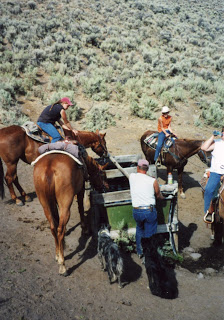
help with cattle work. Here they are in the middle
of a long, hot cattle move, pausing at a water troughon the range to let their horses and dogs drink.
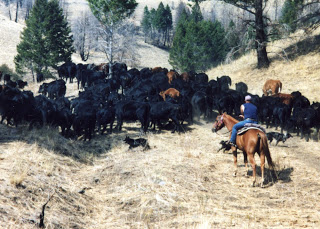
That winter (February 2010) they lost one of their best young cow dogs, Olie, a red border collie. She died in a tractor accident. Every morning when Michael fed cows by himself, taking big round bales out to the field with the tractor, his dogs kept the cows away from the gate so he could drive into the field. One morning he was late feeding, and the cows were crowding around the gate. The dogs were trying hard to keep the cows away from the tractor as he drove through. Olie had a full tail (rather than bobbed) and when she took a step backward because of the encroaching mob of cows, the tractor wheel caught her tail. By the time Michael realized what happened, it was too late to keep from running over the dog.
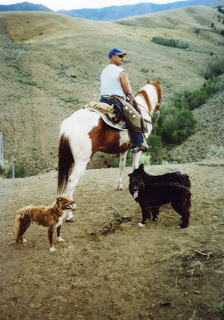
and Tuffy and Tiny — the summer before they lost Olie
So Michael asked Dan if he knew anyone who might have a litter of red border collie pups that spring. Dan told them about the litter his dog Ike had sired. Bruce Mulkey wanted a female from that litter, since Bruce had also lost a good cow dog and needed a replacement. Michael and Carolyn asked for the runt female from this litter.
The pups were born in April 2010. Their mother weaned the whole litter early, at 4 weeks of age. Dan had to take the two female pups early and kept them for 2 weeks at his place in Lima, with Ike. After Michael and Carolyn’s daughter Heather (our oldest granddaughter) got home from her first year at Carroll College in Helena, Montana, they all drove over to Dillon on June 10 to pick up the 6-week-old pups — the one for Bruce, named Tess, and the female runt. Heather started calling the pup Fred as a joke (to get back at her dad for nicknaming her young foal Tornado, also born that year), and the name stuck.
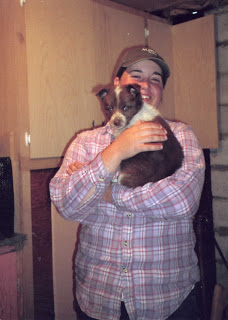
a few days after they got young Fred
From the time they got her, Fred has been part of the family and lives in the house. “We took her everywhere we could, to build a bond and start basic discipline,” says Michael. “We took her irrigating with us, because she was too little to go with the horses when we rode. We kept her in the house because she was so bold and fearless, and we didn’t want her to get out on the road or go to the neighbor’s place,” he says.
“She’s never been afraid of anything,” says Heather. “She’s totally fearless around vehicles, rushing water, horses, and cattle. When we first got her and she was still a tiny pup, Mom would pack her around on the four-wheeler when we went irrigating, then carry her up and down the ditch. She’d jump in the ditch and get all wet, so Mom had to wrap Fred in her coat so she wouldn’t get cold.”
Carolyn recalls that the tiny pup would walk across the dam poles and jump into the ditches no matter how deep they were, and as soon as you set a dam, she thought it was a game, and she’d try to pull it out. From the beginning she invented dozens of games.
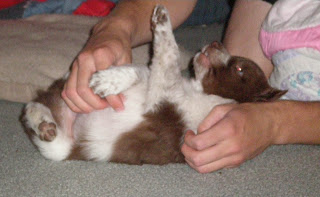
Young Fred had a tremendous herding instinct from the beginning. When our son Michael and his wife Carolyn brought her home as a 6-week-old pup, she was immediately interested in their two house cats and started herding them — even though her short little legs and fat little body weren’t very speedy. She still tries to play with the cats and likes to chase them around the basement.
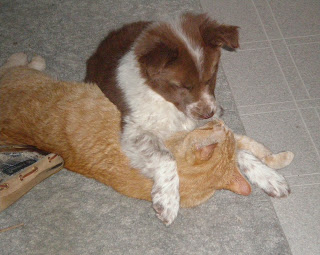
and wanted to herd them and dominate them.
“When we started training her, we asked Dan how he started her sire Ike on ducks, and he told us Freddie was way past ducks,” says Carolyn. She was ready for cows at an early age.Most dog trainers take a young pup with them as much as possible, to build a bond and instill basic respect and obedience. “Our situation was a bit extreme, because there was such an age gap between this pup and our older dogs,” explains Michael. Fred was the new kid on the block, and the older dogs didn’t tolerate her.
“We couldn’t leave her loose outside because there was no bond between her and the older dogs. So she lived with us, 24 hours a day.” She only played briefly with the older dogs in a supervised setting.
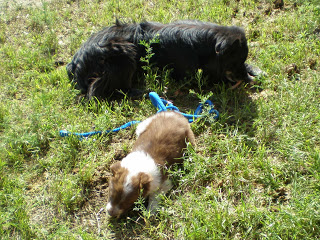
when there was someone nearby to supervise.
Ideally, Michael likes to have a young dog coming along in basic training before the others get too old — and are young enough to accept the pup. “My progression in bringing on another dog would have been perfect, but I’d lost Olie. She was right in the middle, and she’d bonded with the older dogs when she was a pup, and we never had any problems with her fitting in. There was only 3 years’ difference between Olie and Baxter, the youngest of our old dogs, at that time,” says Michael.
“But after we lost Olie and got this new pup, it was an awkward situation, and we had to do something different. There wasn’t the dog in the middle that would bond with the pup,” he explains. Now that Fred is 2 years old, she and Baxter are finally pals and work well together, but she had to earn the right to run with the old dogs.
The family took Fred with them everywhere they went and left her in the pickup or horse trailer when they were riding to move cattle. As a small pup, within a week of when they first got her, she’d grab the trailing lead rope of any horse being saddled, being unsaddled, or waiting to be led back to the pen or pasture, and she’d try to lead it, including the horses Michael was trying to shoe.
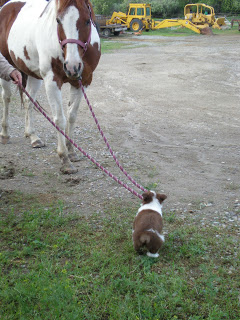
when she was just 6 weeks old.
Fred lived in the house and knew she was special from the start. She went with the family in the car whenever they went to town or out of town. “We always joked that she was far more spoiled than Nick or I had ever been, because any time our folks went out of town she got a new toy!” says granddaughter Heather.
Fred loves to play games and retrieves sticks and has an intense interest in gathering and dragging sticks around. “Her dad, Ike, does the same thing. Fred tries to drag home the biggest stick she can find — even if it’s too big to carry — running as fast as she can,” says Heather. Fred plays a lot of games with sticks and often tries to get Baxter to chase her in a game of keep-away. She’ll tease him with a stick until he goes after her; then she carries the stick and keeps it out of his reach.
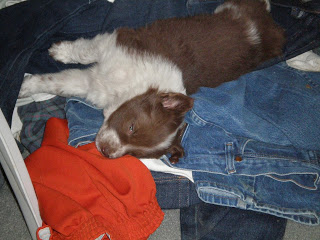
Heather trains horses for other ranchers during summer vacations from college, and Fred is always very helpful. “She tries to desensitize them for me. She’ll pick up one of her big sticks and go charging around the pasture or pen or run behind the horses while they are all tied up to the trailer, trying to see if she can get a reaction. She’ll find an old plastic water bottle and lie there crunching it to see how much noise she can make,” says Heather.
Her first summer they didn’t take her with the other dogs when they moved cattle, just because she was so fearless and so young. “We were afraid she might get stepped on by the horses if she wasn’t paying attention, and we were also worried about rattlesnakes. She didn’t know to stay away from them,” says Heather.
But they still tried to acquaint her with everything at an early age, including cattle. “We’ve done that with all our pups over the years,” says Michael. “We learned an important lesson a long time ago, with two Blue Heeler–cross pups. We went through a winter without letting Nick’s young dog Spud work stock, and by spring, when he was 8 or 9 months old, he was scared of them. He wanted to work cattle; when we got him as a pup, he’d been in a barn with calves and was herding them around. But then he had several months with no cattle contact.”
There are two schools of thought on training pups, and it may depend on the breed. “Some people believe strongly that you shouldn’t start them too young. Other people feel that if they show an interest they should be started on cattle as soon as they are big enough to not get seriously hurt; you should let them tag along. The most important thing, however, is to establish some control in the beginning so you can call them back if you think they may get in trouble or get mauled.
“I almost waited too long with Baxter, to start him on cattle. He was born in late summer, and we got him in the fall; he went through the winter without any cattle experience. By spring, when we took him out for the first few rides, he was scared of cows. Once the light switch clicked, he was eager, but timing is important — and having good role models makes a big difference, too. Every dog is different,” says Michael.
“In our situation, where the county road and neighbors are so close, we kept Fred with us in the house instead of letting her run loose when she wasn’t working cattle. She’s too ambitious, and she didn’t know any boundaries. To prevent her from getting run over or shot, we’ve kept her with us all the time, whatever we’re doing,” he explains.
Fred thinks she’s a human, not only because she’s lived with her people but also because she is exceptionally intelligent. “Her sire Ike is probably the smartest dog I’ve ever been around. He can do anything a world-class sheepdog will do — and do it with sheep or cattle. He’ll gather them, bring them to you, lie down and hold them, all on voice command,” says Michael.
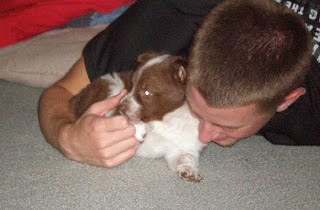
Fred thinks she’s a human because she’s always lived with her people.
“Fred is part of our family and has had privileges the other dogs haven’t,” says Heather. “She has never spent a night outside. When she comes in the house, she’ll wait for us to clean her feet; she knows she has to wipe her feet before she comes in! The other dogs are jealous; even though they get to come in sometimes, they always have to go back out.”
She knows the meaning of many words. “If you tell her to go get her pig (one of her toys), she’ll go find it and bring it to you,” says Carolyn. “She knows the names of all her toys. If you tell her to take her bowl to the kitchen, she’ll pick it up and take it in there. You can also tell her to take something to the garbage. She’s very smart and very spoiled!”
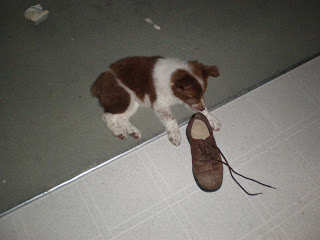
favorite things to play with were shoes.
